Transporting used batteries can present a range of risks to mining operators, transport providers and those involved in chain of responsibility. David Bush is our guest author and is the General Manager of Battery Rescue, an industry supplier of battery collection recycling and transport services to the mining industry. David shared his thoughts with AMSJ on the current issues facing battery collection and storage across the industry and what can be done to control those risks for all involved.
David Bush : Due to harsh operating environments, Australian mine sites produce significant quantities of used lead acid batteries (ULAB). The batteries need to be collected and transported to one of several Australian battery recycling facilities, located on the East Coast of Australia. 98% of a lead acid battery is recycled with the lead, plastic and acid components recovered for reuse.
Unfortunately, the current transportation practices of ULABs from many mine sites is unsafe. It may result in damage to the environment, and in many cases fails to comply with the relevant regulations. Aside from the safety and environmental issues, many companies are unaware of the legal risks of noncompliant transportation.
Recent strengthening of “Chain of Responsibility” laws by the National Transport Commission has increased the consignor’s responsibilities and contingent liability risks. The provisions mean that the consignor, its Directors, Managers and Employees can now be prosecuted and in some instances held personally liable for acts or omission associated with transportation activities.
Why are Most Mining Companies Transporting Used Batteries Non-Compliantly?
Wood pallets are the default standard used by the battery recycling industry to transport ULABs for recycling. Wood pallets are selected due to their low cost and widespread availability which facilitates easy one-way transport. For many remote mine sites this is particularly appealing.
Despite the appeal or wooden pallets, there are many misconceptions regarding obligations. Many mining operators do not understand their obligations or the legal risks regarding transportation of ULABs. Our experience shows that transportation of ULABs via wooden pallets can present significant risks for mining operations.
Australian Code for Transportation of Dangerous Goods
To understand why wood pallets are contributing to non-compliance, we need to examine the packaging and transport requirements in the Australian Code for Transportation of Dangerous Goods (ADGC).
The ADGC’s packaging requirements for ULABs are outlined in the P801 Packing Instruction. When batteries are being stacked in layers on a wood pallet, each layer of batteries must be separated by a non-conductive layer of appropriate thickness to ensure that a superimposed battery is not supported by the terminals of the underlying batteries.
For most batteries this would require a non-conductive layer at least 30mm in thickness. The batteries should then be wrapped in plastic and secured horizontally and vertically by plastic strapping. Finally, the appropriate dangerous goods labels applied.
This is a difficult task for many personnel. Variations in worker’s attitudes, training, non-availability of the required materials and tools (e.g. heavy-duty wood pallets, plastic wrap & straps, strapping tool & 30mm non-conductive separators) may contribute to compliance requirements not being met when using wood pallets to transport ULABs.
The photo right, shows a fire that occurred at a Perth Scrap Metal Yard in 2018. The fire started on the  truck while parked with a load of used lead acid batteries. The cause is suspected to be metal strapping, used to secure the batteries to the wood pallet, resulting in a short circuit and subsequent fire.
truck while parked with a load of used lead acid batteries. The cause is suspected to be metal strapping, used to secure the batteries to the wood pallet, resulting in a short circuit and subsequent fire.
The incorrect application of metal strapping is reportedly one of the most common cause of fires when transporting ULABs. Consignors should use high strength plastic strapping; however metal straps are often used due the unavailability of the plastic strapping.
Below is a typical example of used batteries delivered from a WA mine site to a Perth Scrap Dealer’s yard. Separators have not been applied between the battery layers, but perhaps of greater concern, is that there is no outer strapping of the batteries and the pallets have not been restrained to the vehicle. I have witnessed many variations to this but have yet to see a delivery from WA mine sites, that would fully comply with the ADGC.
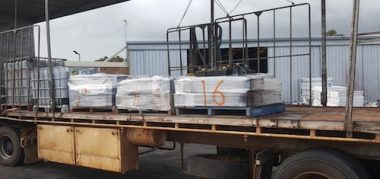
If this vehicle was involved in an accident a few layers of plastic wrapping are not going to adequately secure a heavy load of batteries which would become deadly projectiles. If the batteries contributed to the severity of the accident the mining company (consignor) would be exposed to significant legal risks.
ULAB’s on wooden pallets have shown to be a significant contributing factor in a range of battery transportation incidents across the mining industry. The practice results in substandard compliance levels and clearly exposes industry operator to regulatory and legal risks.
Controlled Waste Regulations
In addition to being a Dangerous Good, used lead acid batteries are designated as a controlled waste with regulations usually administered by the equivalent of an environmental department in each state. Unfortunately, there are variations between the regulations and requirements in each state.
There is more chance of finding a unicorn than a regional transport company, with the necessary used lead acid battery, controlled waste license that is willing to comply with the various provisions.
Our observations have indicated that the controlled waste regulations appear to be largely ignored by the Mining industry and frankly this is not surprising given the requirements are impractical for transportation of ULABs from regional locations. There is more chance of finding a unicorn than a regional transport company, with the necessary used lead acid battery, controlled waste license that is willing to comply with its various provisions.
The financial and legal risks due to non-compliance, appear to be significantly less in comparison to the dangerous goods and heavy vehicle transport laws, particularly if the batteries are already meeting the requirements of the ADGC, OHS and heavy vehicle transport laws. The differences in this instance are, in our opinion, cosmetic.
What is the Health and Environmental Threats Posed by Lead Acid Batteries?
The acid electrolyte contained in lead acid batteries contains high levels of lead and other toxic heavy metals, that are a threat to human health and the environment. The World Health Organisation has identified lead as 1 of 10 chemicals of major public health concern and currently suggest there are no known levels of lead exposure that are considered safe.
The use of wooden pallets increases the risks of spills, contamination and do not prevent battery acid leakage into the environment during their storage and transportation.
Many West Australian’s still remember the lead poisoning incident that occurred in 2006, when lead dust escaped into the environment during transport of ore from a Wiluna mine to Esperance port. The result was one of the State’s worst environmental disasters with thousands of birds dying, 33 people testing for unsafe blood lead levels and the resulting 5-year clean-up costing the state government in-excess of $25M.
While the contamination risks would no doubt be less, there are still concerns of skin absorption from contact with lead contaminated pallets and batteries. This risk was confirmed in 2016 when one of Australia’s largest pallet hire companies’ operational employees, tested for elevated lead levels and resulted in them discounting supply to the NSW Battery Recycler they were servicing.
How Should the Mining Industry be Transporting Their Used Batteries?
Our recommendation to solve the existing risks associated with battery transport is that the mining industry operators should adopt standards requiring the use of heavy duty plastic containers with a lid to prevent the ingress of water and to help restrain the batteries in the event of an accident (cut off IBCs aren’t suitable), such as the examples shown below.
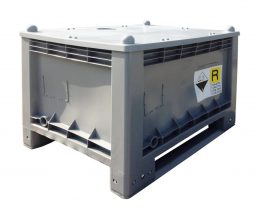
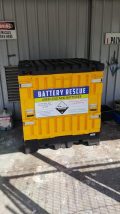
One of the fundamental differences between using wood pallets and a plastic container is that the plastic container needs to be returned. This obviously adds extra logistical complexities, particularly with remote mine sites, however the advent of affordable, battery powered GPS tracking solutions, eliminates many of the challenges posed when operating a closed looped container pool.
Plastic boxes / containers are the main method used in Europe to transport lead acid batteries for recycling, where the bins are automatically unloaded at the recycling plant, thus eliminating the manual handling of batteries and ensuring the battery acid is safely recycled. In time we would like to see a similar model adopted in Australia with the use of wood pallets eliminated from the entire battery recycling industry.
With the increased availability of plastic containers, of suitable strength and capable of retaining acid leaks, Battery Rescue believe its time the industry moved away from the use of wood pallets for storage and transportation of used lead acid batteries. Waste management and scrap metal companies can provide the plastic containers at no cost, to the mining industry and would immediately improve the level of compliance and safety while reducing the risks to employee health and the environment. Transporting used batteries doesn’t need to present risks to the environment and your staff. Used battery transport can be conducted safely and risks can be mitigated with some minor changes that can have positive outcomes across the mining industry.
Read more Mining Safety News


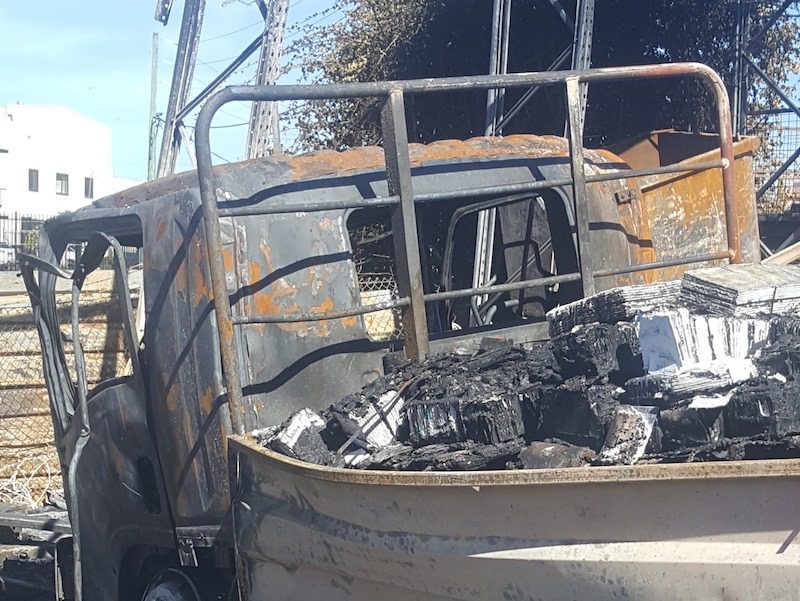
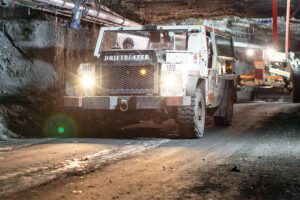










Add Comment